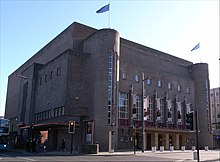Philharmonic Hall, Liverpool
| Liverpool Philharmonic Hall | |
|---|---|

Liverpool Philharmonic Hall
|
|
| Location | Hope Street, Liverpool, Merseyside, England |
| Coordinates | 53°24′04″N 2°58′12″W / 53.4012°N 2.9701°WCoordinates: 53°24′04″N 2°58′12″W / 53.4012°N 2.9701°W |
| OS grid reference | SJ 356 898 |
| Built | 1939 |
| Built for | Royal Liverpool Philharmonic Society |
| Architect | Herbert J. Rowse |
| Architectural style(s) | Streamline Moderne |
|
Listed Building – Grade II*
|
|
| Designated | 19 March 1981 |
| Reference no. | 1279652 |
Liverpool Philharmonic Hall is a concert hall in Hope Street, in Liverpool, England. It is the home of the Royal Liverpool Philharmonic Society and is recorded in the National Heritage List for England as a designated Grade II* listed building. It is not the original concert hall on the present site; its predecessor was destroyed by fire in 1933 and the present hall was opened in 1939.
The Liverpool Philharmonic Society was founded in 1840 but initially did not have a permanent concert hall. In 1844 the Liverpool architect John Cunningham was appointed to prepare plans for a hall. The initial requirement was for a "concert room" holding an audience of 1,500 which would cost at least £4,000 (equivalent to £361,000 in 2015). Later that year the requirement was increased to a "new concert hall" to accommodate an audience of 2,100 and an orchestra of 250, plus "refreshment and retiring rooms". Subscribers were invited to both buy shares and to purchase seats along the sides of the hall. The foundation stone was laid in 1846 and plans were made for Mendelssohn to write a cantata to be played in his presence at the opening of the hall. Mendelssohn did not live long enough to write the work.
The hall cost £30,000 (equivalent to £2.81 million in 2015) and was opened on 27 August 1849 accompanied by a week long festival. A correspondent for The Times reported that it was "one of the finest and best adapted to music that I ever entered". The correspondent described the interior:
The orchestra, on each side of which is a canopied box for the use of the committee or the directors of the concert, is at the east end of the hall, recessed under an arch, filled to the extremities by the instrumental and choral phalanx of executants, disposed semicircularly, with numberless bronze music-stands, each surmounted by a lyre. It has a most imposing appearance. A large organ, of simple but classic design, backs the orchestra. The length of the body of the hall, without the orchestra, is about 104 feet; with the orchestra, about 150 feet. The breadth cannot fall short of 100 feet. The form of the room is oblong. The boxes, 65 in number, are disposed on each side of the hall, under the galleries, which in their turn are surmounted by the brilliant line of gas-burners .... The entire body of the hall is divided into comfortable stalls which leave plenty of room to sit at ease, and have all the accommodation of arm chairs. Three doors for ingress and egress are disposed at each side of the hall, and there are divided by windows, fitted with perforated zinc for the purpose of ventilation. Two immense eliptic arches on each side of the hall, spanning nearly the entire length of the body, inclose the boxes and galleries, and give them the appearance of being recessed. The galleries are sustained by gilded pillars, which front the boxes, with scroll ornaments for capitals. At the west end of the building, opposite the orchestra, there are two galleries, one above the other. The roof is covered, and the covers are of stucco, perforated; the centre is flat, but elaborately ornamented and relieved. The boxes are very elegantly fitted … The hall is lighted in day-time by four large windows, two on either side.
...
Wikipedia

